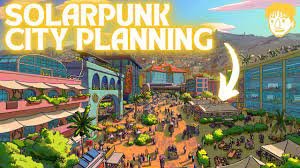Solarpunk is people! - notes on a generic visual identity
If you’ve been searching for solarpunk content online, you might have run across a recent video by YouTube creator DamiLee called “Solarpunk Cities: Our Last Hope?” DamiLee’s channel (from what I understand) is focused on architecture and urban design, and she’s often covered the aesthetic / urban design of various science fiction cities. It’s fascinating; would recommend!
This particular video contrasts solarpunk and cyberpunk from an architectural standpoint, and she makes the very incisive observation that while cyberpunk’s emphasis on Brutalist design gives it a cohesive identity (i.e., you look at the buildings in any snapshot from Blade Runner and you instantly know that this is a cyberpunk film, even if you don’t know the plot), solarpunk doesn’t really have that. And that’s a problem.
The most famous real-world examples of Brutalist architecture come from Soviet Russia, so much that the style is often named "Soviet Brutalism.”
According to DamiLee, this “lack of a common architectural language in solarpunk,” though it might seem to be a small non-issue, is a bigger problem than you may think, as a cohesive architectural style often “serves as the glue that binds social movements or a cultural ethos.” She gives a very compelling example in the post-WW1 Bauhaus movement in art and architecture in Europe, but I want to explore this point about solarpunk a bit more. Because I think the issue is tangled in the very ethos and values espoused by these movements.
In cyberpunk, the city stands in for the government and its dictates. We don’t meet the architects of the skyscraping office towers of the corporations, the brutalist buildings the protagonists walk through, or even the streets or broken geodesic domes* that the proletariat must live in.
There is no individual or community control over urban design in cyberpunk, or none that we’re shown, in any case.** There’s a sense that the individuals are helpless against the powers that be, which is kind of the point: cyberpunk is all about the little guy fighting back against the (mostly) faceless oppressive evil forces that have most of society under their bootheel. It makes sense that the buildings are all cookie-cutter concrete, because it really doesn’t matter if this plot takes place in alternate Minnesota or alternate Moscow; the place is irrelevant, the environment inconsequential, the culture basically erased by imperial corporate imposition.
Solarpunk architecture, on the other hand, embodies the ethos of solarpunk: the valuing of community input, responsive to individuals’ needs and differences, sensitivity to the differing eco-regions and environments across the world, and - to boil it down to a very bare essential - the valuing of people (human and non-human alike), culture, and planet.
I personally think it would be impossible, in that case, for solarpunk architecture to have a cohesive style. Instead, I think what to me makes an aesthetic solarpunk is not a specific type of building or street, but the inclusion of people in those images.
To me, cyberpunk-style Brutalism gives off the sense that the buildings are not built for people, per se, but to fulfill a design dictat or quota regardless of function. The people adapt to the architecture.
In my ideal vision of solarpunk design, the architecture adapts to the people. The values and ethos of the movement shapes the city: the design is responsive to people and place, because the people are empowered to make changes to their dwellings and the architects and builders have faces and names and contact information and the environment is taken into consideration when choosing building materials, et cetera.
Right now in the solarpunk present, I think that realistically people are going to have to adapt to whatever we’re given instead of the other way around. But I also think that it’s worth holding the vision of this solarpunk future city that is informed by responsive design and transparency in the architectural and urban planning processes so that we don’t fall into the trap of thinking that since city design is decided on by (a vague sort of idea of) other people, we must just make do with what we are given, as that’s the way it always has been and always will be.
I believe that we can get to a solarpunk future where our cities are intentionally designed to be functional, beautiful, responsive, sustainable, and ultimately a great place to live, instead of just the places that people have to live.
On that note, I think the idea of manufacturing the ideal solarpunk city for New York, then replicating it to plop into Jakarta, or Iqaluit, or Nome, or Mexico City, or Addis Ababa is not only ridiculous, but goes against the ethos of solarpunk itself. The idea of a singular design that works in every bioregion is unrealistic to me (though I do not hold an architecture degree, and am happy to be wrong, but as someone who lives in a place where it gets pretty cold for half the year, the idea of gaily implementing [for example] earthships (tm) without regard for or significant adaptation to the climate is ridiculous to me).
The cohesive design of solarpunk is its variety and its people, and its ability to adapt and change as necessary to the realities of life in the present, in order to intentionally work towards a better future.
——
*I see you, Johnny Mnemonic.
**Although if you have an example I’d love to see it!




